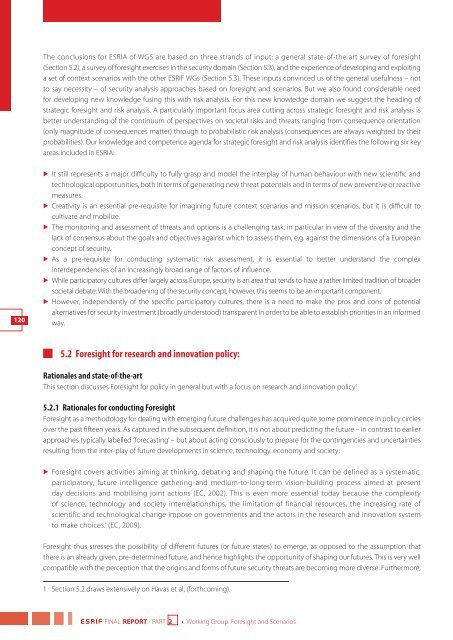I527-290 ESRIF Final Report (WEB).indd - European Commission
I527-290 ESRIF Final Report (WEB).indd - European Commission
I527-290 ESRIF Final Report (WEB).indd - European Commission
You also want an ePaper? Increase the reach of your titles
YUMPU automatically turns print PDFs into web optimized ePapers that Google loves.
120<br />
The conclusions for ESRIA of WG5 are based on three strands of input: a general state-of-the art survey of foresight<br />
(Section 5.2), a survey of foresight exercises in the security domain (Section 5.3), and the experience of developing and exploiting<br />
a set of context scenarios with the other <strong>ESRIF</strong> WGs (Section 5.3). These inputs convinced us of the general usefulness – not<br />
to say necessity – of security analysis approaches based on foresight and scenarios. But we also found considerable need<br />
for developing new knowledge fusing this with risk analysis. For this new knowledge domain we suggest the heading of<br />
strategic foresight and risk analysis. A particularly important focus area cutting across strategic foresight and risk analysis is<br />
better understanding of the continuum of perspectives on societal risks and threats ranging from consequence orientation<br />
(only magnitude of consequences matter) through to probabilistic risk analysis (consequences are always weighted by their<br />
probabilities). Our knowledge and competence agenda for strategic foresight and risk analysis identifi es the following six key<br />
areas included in ESRIA:<br />
It still represents a major diffi culty to fully grasp and model the interplay of human behaviour with new scientifi c and<br />
technological opportunities, both in terms of generating new threat potentials and in terms of new preventive or reactive<br />
measures.<br />
Creativity is an essential pre-requisite for imagining future context scenarios and mission scenarios, but it is diffi cult to<br />
cultivate and mobilize.<br />
The monitoring and assessment of threats and options is a challenging task, in particular in view of the diversity and the<br />
lack of consensus about the goals and objectives against which to assess them, e.g. against the dimensions of a <strong>European</strong><br />
concept of security.<br />
As a pre-requisite for conducting systematic risk assessment, it is essential to better understand the complex<br />
interdependencies of an increasingly broad range of factors of infl uence.<br />
While participatory cultures diff er largely across Europe, security is an area that tends to have a rather limited tradition of broader<br />
societal debate. With the broadening of the security concept, however, this seems to be an important component.<br />
However, independently of the specifi c participatory cultures, there is a need to make the pros and cons of potential<br />
alternatives for security investment (broadly understood) transparent in order to be able to establish priorities in an informed<br />
way.<br />
5.2 Foresight for research and innovation policy:<br />
Rationales and state-of-the-art<br />
This section discusses Foresight for policy in general but with a focus on research and innovation policy 1<br />
5.2.1 Rationales for conducting Foresight<br />
Foresight as a methodology for dealing with emerging future challenges has acquired quite some prominence in policy circles<br />
over the past fi fteen years. As captured in the subsequent defi nition, it is not about predicting the future – in contrast to earlier<br />
approaches typically labelled ’forecasting’ – but about acting consciously to prepare for the contingencies and uncertainties<br />
resulting from the inter-play of future developments in science, technology, economy and society:<br />
Foresight covers activities aiming at thinking, debating and shaping the future. It can be defined as a systematic,<br />
participatory, future intelligence gathering and medium-to-long-term vision-building process aimed at present<br />
day decisions and mobilising joint actions (EC, 2002). This is even more essential today because the complexity<br />
of science, technology and society interrelationships, the limitation of financial resources, the increasing rate of<br />
scientific and technological change impose on governments and the actors in the research and innovation system<br />
to make choices.‘ (EC, 2009).<br />
Foresight thus stresses the possibility of diff erent futures (or future states) to emerge, as opposed to the assumption that<br />
there is an already given, pre-determined future, and hence highlights the opportunity of shaping our futures. This is very well<br />
compatible with the perception that the origins and forms of future security threats are becoming more diverse. Furthermore,<br />
1 Section 5.2 draws extensively on Havas et al, (forthcoming).<br />
<strong>ESRIF</strong> FINAL REPORT - PART 2 • Working Group: Foresight and Scenarios

















